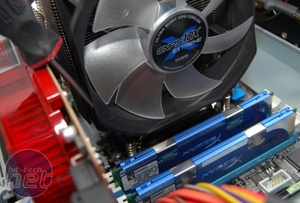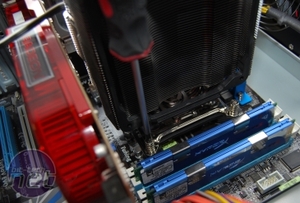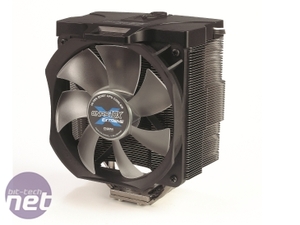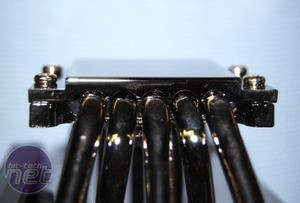Zalman CNPS 10X Extreme
Manufacturer: ZalmanUK Price (as reviewed): £45.06 (inc VAT)
US Price (as reviewed): $74.99 (exc tax)
The CNPS 10X Extreme is Zalman’s first tower-type CPU cooler, and is a noticeable departure from its previous flower-type designs. While this cooler looks similar to the Zalman CNPS 10X Quiet, there are a few differences. The aluminium fins of this cooler are nickel plated, the fan spins faster and is louder, and the Extreme comes with a PWM Mate rather than the Fan Mate 2 of the Quiet.
The PWM Mate lets you set four levels of PWM-based fan speed, 100 per cent, 75 per cent, 50 per cent and Manual. This means that you can set the maximum fan speed but still benefit from the advantages of PWM fan speed management. PWM is preferable to the voltage throttling of the Fan Mate 2 as it allows the temperature sensor of the fan to determine how fast it should spin, ensuring that if the temperature gets too hot the fan spins harder and that when temperatures are low the fan can spin slower and quieter.
The 'Manual' PWM setting lets you set a PWM level manually by rolling the dial of the PWM Mate back and forth. Quite why you'd need this level of PWM control on top of the three settings offered via the button is beyond us - there's control, and then there's control, and frankly the Manual PWM function strikes us as unnecessary.
Fitting the Extreme is a fiddly job, and the manual doesn’t make it any easier. Rather than explicitly stating that each Intel socket requires different components and fitting technique, it tries to deal with LGA775 and LGA1156 at the same time. Manual deciphered, the first step of installing the Extreme was screw a plastic clip to the motherboard via four long screws and four plastic nuts. Then we could use the supplied Zalman ZM-STG2 TIM to cover the CPU before moving onto the messing around with the metal hold-down.
The heatsink goes between the two inner lips of the hold-down, and as you screw the hold-down into the plastic base, the heatsink is clamped to the CPU’s IHS. However, this isn’t the end of the story.


We found it best to ignore the manual and detach the fan when installing the Zalman CNPS 10X Extreme.
Zalman recommends you don’t detach the 120mm fan as you screw the hold-down into the base, but this means that you have to tighten two of the screws with your screwdriver at an angle to the screws. Needless to say, you’re never going to tighten them particularly well and on our first run the CPU hit its thermal throttle limit and stepped down our overclock pretty quickly.
Scratching our heads, we started playing with the heatsink and found it very wobbly in its mount – hardly a sign that the heatsink is clamped to the CPU with anything like enough force. We therefore threw the manual away and went about fitting the Extreme in a better way. This meant removing the memory from the board and then the fan of the cooler (which is held on by four screws) so that we could tighten the screws of the hold-down plate. Job done, we then had to re-attach the fan. This is very tricky as the fan attaches to the heatsink via short 3-pin fan header so that it can talk to the PWM Mate, and even when that is re-attached, you need to screw in the four screws.
Results and Conclusion
With our fitting method nailed, the Extreme still didn’t cool particularly well – our overclocked and overvolted Lynnfield CPU idled at a delta T of 11°C on any PWM Mate setting and reached a delta T of 63°C under full load. This is the same temperature as the cheaper Zalman CNPS10X Quiet achieved when it was on its much quieter full fan speed. The cooler scores 3/10 for ease of use as the manual is misleading and even when I told an experienced member of staff the correct fitting method to use, he still failed to fit the cooler adequately and promptly asked for another - given this person's experience, this is a critical failing of the mounting method of the cooler.Probably worse for Extreme is the fact that, like the Quiet, the heatsink doesn't really get that hot, which indicates that the heatpipes aren’t working well. Looking at the contact plate it’s clear to see why – the heatpipes aren’t bonded to the contact plate particularly well, with gaps above and below. If the contact plate can’t transfer the heat of the CPU into the heatpipes, then the heat will stay around the CPU area and not be sucked up into the large bank of aluminium fins. Zalman needs to address this manufacturing/design problem with its 10X heatsinks because right now, an Extreme, it isn't.
- Features
- x
- x
- x
- x
- x
- x
- -
- -
- -
- -
- 6/10
- Performance
- x
- x
- x
- x
- x
- x
- x
- -
- -
- -
- 7/10
- Ease of Use
- x
- x
- x
- -
- -
- -
- -
- -
- -
- -
- 3/10
- Value
- x
- x
- x
- x
- -
- -
- -
- -
- -
- -
- 4/10
- Overall
- x
- x
- x
- x
- x
- -
- -
- -
- -
- -
- 5/10

MSI MPG Velox 100R Chassis Review
October 14 2021 | 15:04











Want to comment? Please log in.